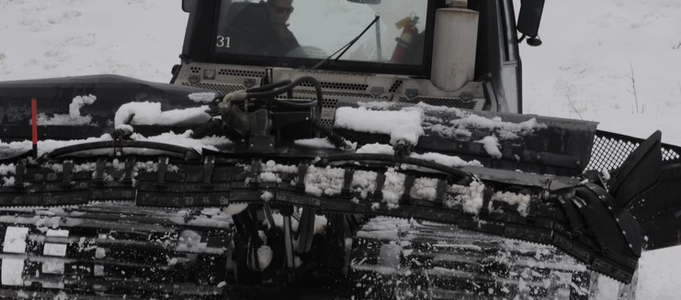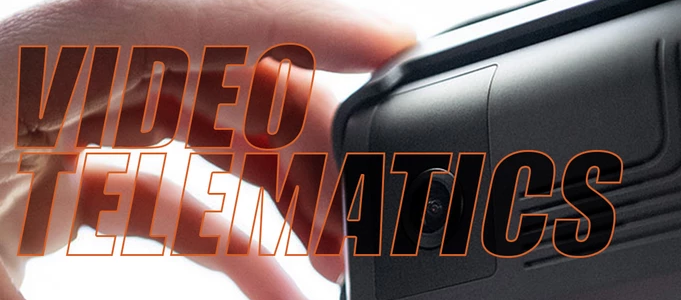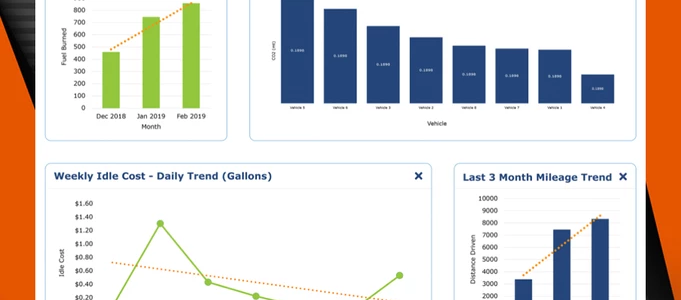Adding a Video Camera Solution to Your Fleet Gives You a Competitive Advantage: Here’s How
Incorporating video to your fleet management strategy has many benefits. Video camera solutions provide important real-world data for driver coaching and safety but choosing one may seem overwhelming. Here are five questions to ask, before you decide on which dashcam to buy.
1. What problem are we trying to solve?
This is the single most important question to ask, and is often overlooked. Consult your business partners or other members of your organization to uncover the issues that need action. Here are some of the common video telematics use categories that we see:
-
Driver risk management — Monitor, score and coach drivers to reduce crashes.
-
Collision evidence — Capture on-road events to protect the company against litigation.
-
Security recording — Use cameras to monitor the security of valuable cargo and confirm the safety and quality of customer service.
2. Who will use and manage the videos?
It’s worth taking the time to list all the people who will use the video telematics portal and the information that it provides. Who will see the data? What is their job? Will video increase or decrease their current workload?
Failing to map out all the potential users in advance has drawbacks such as having the system underutilized. As well, if managers are not looped in early on, they could be surprised or disappointed later if it turns out the system does not meet their expectation.
3. What operations will it need to integrate with and enhance?
Integration is key for efficiency, for any kind of software, and especially video. If you will use video cameras for first notice of loss (FNOL), you will probably want to link the system to your Claims Processing department or service. A driver risk management video workflow output will likely need to link into your HR system. If you want video to fulfill a security function, you probably need a way to share data with the group that handles incident and loss investigations.
Thinking about these linkages in advance will allow you time to research whether the solution is supported by APIs that can enable or even automate data flow between systems.
4. How will we measure success?
To measure your return on investment, there are a number of metrics you can track. Your ROI won’t always be dollars. There are so many key performance indicators (KPIs) for fleet video cameras. Here are a few ideas below of some possible data points.
Types of camera metrics:
-
Risk management (Number of collisions per million miles, Risk rating)
-
First notice of loss (Claims processing time, Number of at-fault claims)
-
Security (Repair costs, Complaints)
Defining your success metrics in advance will make your camera search easier. You can check each camera option to ensure it delivers the analytics you need to measure performance. As well, prepare a weekly or monthly report for stakeholders to foster buy-in and support for your camera goals.
5. What are our future goals?
The final step of preparation before purchasing is to think of the future. How will your fleet change in the next 1-2 years? How about in 5 years? Take note of any upcoming shifts in business operations, vehicles or staffing. These changes will impact what dashcam features you need. Even if you won’t use these features or reports now, it makes sense to invest in technology that will stay useful in the long run.
As well, plan for success. Once you have achieved your first objectives, what will be the next goal you want to set? As your partner when it comes to meeting your fleet management goals, we are here to address all your video camera solutions questions or concerns.
6 Ways Telematics can help you get your vehicles ready for winter easier
It may seem premature to begin thinking of winterizing your fleet months ahead of the winter season, but now is the perfect time to do so. There are multiple reasons to get a head start on this but one is so important that it alone should get you motivated to start the process today: a shortage of vehicle production due to the semiconductor chip shortage means replacing faulty plows and other vehicles will become a problem. In summary, you will need to maximize the fleet you currently have and that starts with proper maintenance.
We have compiled below six ways to winterize your vehicles now so they better serve you all through the upcoming winter:
Make sure your winter wipers are in prime condition
Winter wipers come with a rubber covering that keeps ice from collecting on the blades. Travelling with a bad set of wipers can be dangerous if the rubber has deteriorated or has become torn from sitting under the hot summer sun.
Switch to winter tires. In the winter, ice and sleet contribute to dangerous, slippery road conditions. Below 7 degrees Celsius, around 44.7 degrees Fahrenheit, regular tires (all-season or summer type) harden and begin to lose their traction on the road. The right set of tires can offer huge advantages in bad winter weather.
Monitor tire pressure. Tire pressure drops roughly 1-2 pounds for every 10 degrees Fahrenheit that the temperature lowers. On newer vehicles, an in-vehicle alert for low tire pressure will be visible to the driver; older vehicles require drivers to check tire pressure manually. Geotab data can easily offer tire pressure information through its fleet management solutions.
Vehicle batteries can behave differently in winter. Make sure your drivers don’t get stranded at any point without being able to turn on the heater by prioritizing battery health checks. A vehicle’s battery and charging system might work well during spring and summer, but in winter your vehicles need a little more “juice.” More power is needed to start your engine in the cold, and you also get less power from your battery.
Stay on top of regular servicing. Certain vehicle components have a higher risk of failure in the winter. Bad hoses, belts, water pumps and spark plugs can cause your drivers to become stranded on the side of the road. Implement regular, preventive maintenance servicing during the winter months with automation. A predictive maintenance system can help decrease downtime and costs, and minimize unforeseen component failure. By pre-scheduling maintenance before the change in seasons, you can help ready the fleet for harsh winter conditions. Learn more about proactive maintenance by giving us a call today.
Prevent on-road breakdowns with Electrical Systems Rating (ESR) in MyGeotab. The rating system measures the health of a vehicle’s electrical system on a scale from 0 to 100, with four status categories: good, fair, caution and poor. At Caution, the fleet should schedule maintenance for the vehicle; at Poor the battery is likely to fail. An added benefit to fleet managers is that they can avoid preventative battery replacements unless the ESR reaches the Caution level. Ratings are calculated daily for every vehicle in the fleet.
Ready to optimize your winter fleet? Let us show you how simple it is to use our web-based software and fleet tracking devices to manage your winter operations fleet.
How To Empower Your Drivers and Reduce Risky Behavior
Everyone knows that they shouldn’t check their phones or take their eyes off the road while driving, yet despite this, preventable distracted driving incidents cause over 3,000 fatalities a year.
Your drivers are no different. No matter how well-defined your policies are, how frequently you have driver training, or how enticing your safety performance rewards are, drivers are human and optimism bias comes into play.
Distracted driving is on the rise
Distracted driving is not just detrimental to the safety of people on the road — it also costs companies about $60 billion a year in vehicle repair, loss of productivity, litigation fees, settlements, rising insurance costs, damage to customer relationships and reputation.
The only way to prevent this potentially catastrophic damage to your bottom line and manage risks within your fleet is to empower your drivers to improve their driving habits.
Easy enough to say, but how can it be done?
Using advanced technology to mitigate distracted driving
Think about your approach to fleet safety — is your company proactive about avoiding incidents from occurring, or are your policies reactionary to deal with the aftermath of a negative event? The best way to deal with incidents is to take measures to avoid having one at all. A proactive approach includes an important mix of driver education combined with advanced video telematics designed to prevent incidents from occurring.
Today’s innovative solutions, as the Surfsight dashcam, offer technology like machine vision and artificial intelligence (MV+AI), combining video telematics with driving data to help solve industry problems such as distracted driving.
Dashcams powered by robust MV+AI technology proactively detect distracted or unsafe driving behaviors in real-time and send an audio alert to drivers. Making drivers aware of these actions as they happen empowers them to avoid incidents before they occur. Real-time alerts also help make them aware of their habits, making it easier for drivers to develop safer driving behaviors and improve their overall performance.
MV+AI can also trigger video events, providing managers video proof of incidents to be used for driver training or driver exoneration in case of a false claim. Integrating this cutting-edge technology into your telematics stack provides a wider range of insights into driving behavior, giving fleets the data they need to help improve productivity, efficiency and safety.
Learn more about the capabilities of this powerful MV+AI technology by contacting our team at Info@advtracking.net
Drive enterprise wide decisions using fleet data
For the better part of two decades, telematics has grown and evolved to add new technology around a fleet’s core functions. The addition of cameras, sensors, trackers all have improved this functionality to the point where they are “table stakes” to run a fleet at the highest level.
So the question now is: What is next? What will drive actual new innovation in an enterprise via the fleet?
The next innovations in telematics
While innovations such as video cameras, a stronger sensor, or embedded hardware may improve the functionality of the fleet itself, they won’t really disrupt how we view things and understand them.
Telematics has reached an inflection point. For the fleet to contribute more value to the overall organization, we must begin to really understand the data from the fleet, and more importantly how to share this information beyond the fleet managers into the greater organization.
Enterprise software
Companies literally spend hundreds of millions of dollars on their internal software platforms. They are the lifeblood of the company. SAP, Oracle, Salesforce, Workday, Google, Microsoft, and Coupa, are some of the largest platforms in the world for running global businesses. The fleet is one of the most compelling places in the supply chain to improve and drive innovation.
For companies to take the next step in process improvement, the fleet must share information seamlessly so decision makers in the entire organization have access to the data the fleet produces and can continue to innovate using it to make key decisions.
Integration of fleet data to benefit teams throughout enterprise
Don’t let fleet data stay in a silo, mostly unused by teams that could drive real value from it. Consider what else could be done by taking the data from the fleet into the company’s enterprise software stack:
-
HR can create an accurate record of who the best drivers are, ensure they are rewarded and compensated so they don’t leave, as well create an accurate legal record of the drivers who are putting the company at risk to reduce any sort of legal liability when terminating a driver for cause.
-
Fleet costing and financial performance into the ERP system for the finance team to benchmark performance against global standards and monitor the progress of cost saving programs.
-
Determine what impact will adding electric vehicles have on carbon emissions to the CSO.
-
Direct digital twin location data from the fleet flowing into the supply chain software.
-
Funnel alerts on required components about to fail into the procurement software so they can proactively be ordered.
-
Implement fraud detection into the expense management software if employees are abusing fuel cards for personal use.
-
Link sales team’s customer visits into the CRM based on vehicle stops at stored addresses in the software….etc.
To learn more about how Advantage Asset Tracking can help, contact us today to speak with one of our representatives.
Debunking the Top 5 Telematics Myths
The reasons for any misconceptions around telematics are mostly due to a misunderstanding of the product. Common vehicle tracking myths range from how the devices “monitor” vehicles and drivers, to what the capabilities are, to its costliness to businesses.
Here are the top 5 telematics myths:
1. Telematics Means Big Brother Is Watching
Telematics tracks information about a vehicle and how you use it. With vehicle telematics, there are tiers of the technology depending on the need of the business. It ranges from a simple GPS tracker that will just tell you where a vehicle is located, all the way to a robust telematics system that allows you to monitor vehicle health, manage productivity, improve fuel efficiency, stay compliant with government regulations, and keep drivers safe.
The vast majority of fleet managers aren’t interested in and don’t have time to watch each driver minute by minute. This is especially true for large fleets that might have hundreds or thousands of drivers. They are more concerned with using telematics data to help meet company goals, such as reducing fuel costs or minimizing the number of accidents. In fact, some companies use telematics data to score and reward safe and fuel efficient driving performance — not just bad.
2. A Telematics Device Will Interfere With Performance of the Car or Void the Warranty
In the U.S., the Moss Magnuson Warranty Act of 1975 specifically prohibits manufacturers from voiding the warranty due to aftermarket additions to the vehicle. So, as long as proof of defect can be attributed to the car manufacturer, then your warranty is valid and enforceable regardless of whether or not you attached an aftermarket part. Plus, the device is in no way changing the vehicle mechanically — think of it more as an engine data viewer and translator. It can see engine performance information and send that information back in a tangible way for use as business intelligence.
3. Drivers Will Lose Driving Time
It’s common to believe that telematics will require more effort and input from your drivers because they’ll have to play with the device or log information. That’s not true. When a driver turns on the ignition, a device automatically starts collecting and transmitting data as needed. The only situation where a telematics device will require driver input is when the device is being used as an electronic logging device (ELD). And in that case, the system is replacing a paper log system, so the opposite is true with ELDs.
4. Telematics Track Dots On a Map
The terms telematics and GPS devices are often used interchangeably, which has led to the common assumption that telematics places “dots on a map.” While a telematics device has GPS tracking capabilities, this represents the technology in its simplest form. A telematics device allows you to track information like a driver’s speed, idle time, hard braking, and more. You can use it to optimize your fleet and reduce costs, keep vehicles on a regular preventive maintenance schedule, predict battery failure ahead of time, make fuel tax reporting a breeze and more.
5. Telematics Is Too Expensive
“Telematics is going to cost me thousands of dollars to implement,” is something we hear often from smaller businesses. Depending on fleet size, your needs, and the vendor you select, telematics can be as expensive as $1,000 per month for an enterprise-sized corporation or as affordable as $15 a month for a small business.
When looking at a telematics solution, you will have to compare hardware, software, and installation costs. Advantage Asset Tracking offers a variety of different data plans depending on what the fleet is ready to manage, plus a seasonal plan. Additionally, a telematics device should be thought of as an investment, not an expense, and the ROI should be considered, such as how a company recoups the cost of the service by using the software to tackle goals such as reducing fuel use and lowering maintenance costs.
How to make your electrifying transition seamless
With the emphasis on fleets to reduce greenhouse gas emissions, an increasing number of fleet managers are compelled to inquire about the viability of adding electric vehicles (EVs) to their fleet. What you might be looking for is an electric vehicle suitability assessment.
A few questions that fleet managers may be asking include:
-
Which electric vehicle models are available in the local market? Are they able to perform the job requirements?
-
Is switching to EVs viable from an operational and financial perspective?
-
Which of my current fleet vehicles are good candidates to be replaced by EVs?
-
What kind of charging infrastructure is required to support my electrification plan?
-
What would the greenhouse gas reduction be?
The role of telematics in an EVSA
An EVSA can be as simple as a back-of-an-envelope calculation of cost savings based on estimates and averages, or as complex as running second-by-second physics model simulations of each EV under consideration.
A good middle-ground would be to remove the guesswork out of trip information and utilize data collected through the telematics solution installed within the fleet. Telematics solutions provide access to a rich set of data points that can be used to refine the accuracy of such an EV assessment.
To start, we can get accurate daily driving distance readings and compare them against the real-world range of EVs available in the market. Furthermore, having accurate fuel consumption readings can refine the fuel savings calculations and increase the accuracy of the financial model.
A more advanced assessment can use location information to get data on the local terrain where vehicles are driven. This data can be correlated to outside temperatures to figure out when to factor in climate control systems when modeling the EV battery capacity. More advanced models can look at driving behavior parameters such as speed, hard acceleration and braking to further refine the estimated range of an electric vehicle under the same driving patterns. With Geotab’s support, we can help make your transition as seamless as possible. Contact us to learn more.
Everything You Need to Know About Video Telematics
We’re seeing an evolution from normal dash cameras to video telematics now that vehicle cameras are becoming more important to have in fleets. There are two key advantages with video telematics over a typical dash camera. The first is that managers can use video telematics to identify and modify risky driving behavior. The second benefit is that managers can receive timely video evidence of critical incidents — called “first notification of loss (FNOL)” by insurers.
What Exactly are Video Telematics and Their Cameras?
Video telematics is a technology that integrates cameras and analytics with fleet tracking. Companies can use video telematics as a tool to record collision evidence, for driver risk management, or security.
A telematics camera refers to the hardware part of the solution. To get the most value, look for a compact, high-resolution camera with generous storage capacity, multiple recording modes, and GPS/GLONASS. Other useful video telematics camera features include an internal microphone, Wi-Fi connectivity, and 4G/LTE data transmission.
How Video Telematics Works
Fleet video telematics combines vehicle data and driving data to provide more context around any incident footage while transmitting the video evidence in real-time over a cellular network.
Multiple camera options are available, including:
-
Road-facing only
-
Road and driver-facing
-
Multi-camera (4 total cameras inside and/or outside the vehicle).
MyGeotab users can easily view their video telematics data right from their software application. Having all their fleet data in one place makes it easier to analyze and act on the information.
Benefits of Video Telematics
In the case of a collision, video telematics can help provide the answers to who, what, where, when, and why. Telematics technology plays an important role in improving the safety of drivers and others on the road.
Here are more benefits of telematics with video:
-
Immediate notification of incidents — manage the direction of claims through early interception
-
Remote access to video footage — instant access when needed by the claims department
-
Vehicle tracking and monitoring — the speed and behavior metrics and whether the vehicle was in the area of the incident at the time
Is Video Telematics Right for Your Fleet?
We pride ourselves in uncomplicating any telematic integration so contact us a call today to learn more about video telematics and whether it is the right tool for you. With so many options out there, we bring simplicity to your search for the perfect fleet tracking solution.
How to choose the right reservation partner
Keyless technology — that which allows users to embed the key of a vehicle into a cellular and Bluetooth connected piece of hardware — is gaining increasing popularity and reservation technology can now take this shared mobility to the next level.
Rental companies can use reservation solutions to improve their customer experience by removing queues and paperwork. Car sharing companies can make improvements through web and mobile app reservation systems. Fleets can streamline the management of internal mobility of employees. With so many options out there, how do you choose the best provider? Read on to learn about the five things to keep in mind before choosing a reservation partner.
1. What should be considered when looking for a partner?
Start by making a list of different partners that offer the solution you are looking for. Then, narrow the list down based on what problem you are trying to solve. Software services can be broadly categorized but are all very unique in what they can best provide. Sticking to what is most important for your company will help to make a proper assessment.
2. What features and integrations should a company be looking for?
While this depends on the specific requirements you need, there should always be a solid foundation of the basic features and functionalities. A few features to look for include:
-
Internet connectivity
-
Bluetooth
-
NFC reader
-
Data hosting
-
Simple and easy-to-use interface
Additionally, ask how long the system takes to set up. Your partner should also have the ability for general integrations including payment services providers, all hardware-related connections as well as customer relationship management (CRM) and analytics tools. A bonus is having an open platform system with well-documented APIs to allow for custom integrations and extensions.
3. How important is it to find a partner who has specific features and integrations?
It’s very important to find a partner that can cover the requirements to keep your business running smoothly. Above the features and integrations, It is more important to find a partner that you can rely on and that is willing to support your goals. We believe that having a partner that asks why instead of just how is critical because that is often the best step to take towards solving challenges together.
4. How does choosing a reservation partner affect a business overall?
Reliability of the system is important to allow day-to-day business operations to keep running smoothly. The right reservation partner can support your business effectively by sharing best practices and providing the right tools to help you grow. In addition to supporting your core business, a good partner will be equipped with the technology needed to handle requests and be there whenever you need them.
5. What is the most important advice for a business looking for a reservation platform?
Focus on what matters most for your business and do not get distracted by nice-to-have features and functionality. The core stability and reliability of any system prove to be most important for any business that offers live services. It is up to you to decide which features and integrations are most important.
Your Next Step
Geotab has made the process easier for you by partnering with software reservation companies that we know can get the job done. Our partners are reliable and can help you take your business to the next level. All software reservation partners are fully integrated into our Keyless solution, offering fully digitized keys for secure keyless entry and remote vehicle management.
What is a fleet management dashboard?
There are many different types of reports that managers can use to increase efficiency and productivity within your fleet. The two main categories of reports include: fleet dashboard and email reports. In this post, we’ll discuss the difference and benefits of each type of report. Let’s jump right in.
What is a fleet dashboard report?
Any report that measures the fleet and is graphical can be considered a dashboard report.
What are the benefits of dashboard reports?
Dashboard reports give you a visual representation of the condition of your fleet and how it is performing. It is used to make decisions at a glance.
An example of a popular Geotab dashboard report
The Watchdog Report is a default dashboard report for MyGeotab to better understand device health and communication. Managers can use this report to identify in real-time any device status issues, including:
-
unplugged devices
-
lost service
-
devices not installed
“Not installed” devices are Geotab GO tracking units that have been added to the database but they have not communicated yet. Fleet managers can customize the refresh period to their specific needs. It can be set up as frequently as every 30 mins, daily or even quarterly.
How often would you check the dashboard report?
The frequency could range from once a day to as needed depending on the use case. As far as routines, it is important to set the proper next run and refresh times. When managers understand the times their reports have the latest data, that is what can guide them on the frequency of checking their dashboard.
Now let’s discuss email reports.
What are fleet management email reports?
A fleet management email report is any report, including both custom and built-in, that provides key insights about the fleet and can be sent via an email through MyGeotab. Email reports are available in either a PDF or excel format.
What are the advantages of emailed reports?
The key benefit of emailed reports is that people don’t have to go somewhere to find them. Emailed reports can easily summarize data, charts or graphs and be pushed directly to a person’s inbox. There are several clear advantages to setting up email reports:
-
Send reports to those who don’t have access to data within the database due to security clearances
-
Being able to email reports keeps individuals informed within the organization
What kind of reports do fleet managers set up to be emailed?
Here are a few examples of popular email reports for fleet management:
-
Maintenance Reminders Report
-
Safety Scorecard
-
Watchdog Report
-
any report you have configured to be conditional
How do you set up email reports?
Find out how to set up an email report in this Geotab Community post.There is also an instructional video that shows how to automate reports.
How can the frequency be determined?
Frequency depends on the mission of the fleet manager. Think about how often you need the information from the report (daily, weekly, monthly or annually).
Some fleet managers choose to set up and receive rolling reports which include the last 24 hours of data. The benefit of a rolling report is that it gives a manager the information needed to make decisions at the beginning of a shift.
Take advantage of these reports
Using fleet dashboard and email reports can help take your fleet to the next level. A robust fleet management and reporting system can also lower costs and help with safety and compliance.
Let us know if this information was helpful in the comments section.
How a Fleet Dash Cam Reduces Risks and Keeps Drivers Safe
An accident has just happened with one of your fleets and your telematics solution is at the ready with valuable information. You then discover that you’re even more ahead of the game thanks to the in-car video system you’ve recently installed in all our fleets. While telematics has the ability to tell you what happened, video goes a step further by showing you the reason why.
Mobile video technology has emerged as a powerful tool for fleet operators to maximize the value received from telematics while helping fleets reduce risk and keeping drivers safe. Dashboard cameras can be very beneficial for companies because they provide an objective record of what happened during an accident. Having a dash cam often eliminates the need to unravel the conflicting perspectives of the affected parties in an accident. The camera can clearly show important facts like who had the right-of-way or if speeding was a major cause. This can go a long way in defending a driver and reduce fraudulent claims of injuries or accident set-ups.
Dash cams are also useful for fleet managers to monitor drivers and identify those who may need extra training or discipline. A periodic review of footage from vehicle cameras can help managers improve their drivers’ safety behind the wheel.
Benefits of an In-Car Video System
In-vehicle video camera systems deliver powerful benefits to fleet operators in the form of:
-
Better Driver Risk Management
-
Accident Management
-
Operational Effectiveness
-
In-Cab Safety
The best driver risk management (DRM) programs now incorporate event video to isolate the root causes of driving behavior and provide better coaching during training sessions. Telematics data identifies good and bad driving based on data points like speed, hard turning, acceleration and others. Video then isolates the specific driving habits that cause the risky behaviors. Are harsh braking events caused by following too close or by distracted driving? Video also motivates better in-cab performance, dramatically reducing the frequency and severity of critical incidents.
The proper handling of accidents when they happen has become an essential element of fleet management. Timely video evidence of critical incidents and accidents, called “first notification of loss (FNOL)” by insurers, helps exonerate drivers and fleet directors in personal injury cases, and criminal or regulatory prosecutions. Even when the driver is at fault, FNOL reduces the cost of insurance processing and payouts by up to 40%, keeping your premiums in check.
When it comes to operational effectiveness, the real-time situational awareness provided by an in-car video system helps refine operations, improve customer relations and increase profitability. Did complications at the customer site impede delivery? Was the driver off-route for personal or professional reasons? Are road, weather, traffic or other route conditions impacting fuel consumption and vehicle wear and tear? Answers to such questions become readily available with the use of in-vehicle video camera systems.
Finally, in-cab safety monitoring can help employers reduce risk and keep drivers and passengers safe. According to the U.S. Department of Labor, every 12 minutes someone dies in a motor vehicle crash, every 10 seconds an injury occurs and every 5 seconds a crash occurs. In addition to the emotional toll it takes on a business when a fatality occurs or an employee is wounded in an accident, work-related vehicle incidents can become very costly to employers and drivers. Dash cams can become instrumental tools in ensuring driver safety and preventing accidents from happening.
The Right In-Car Video System for You
Choosing the right mobile video solution for your fleet is easier than ever. Advantage Asset Tracking explains some of essential features to look for when considering mobile video solutions. Count on our dedicated team to always prioritize your individual business needs and provide solutions that meet your operational requirements and resource allocations.











